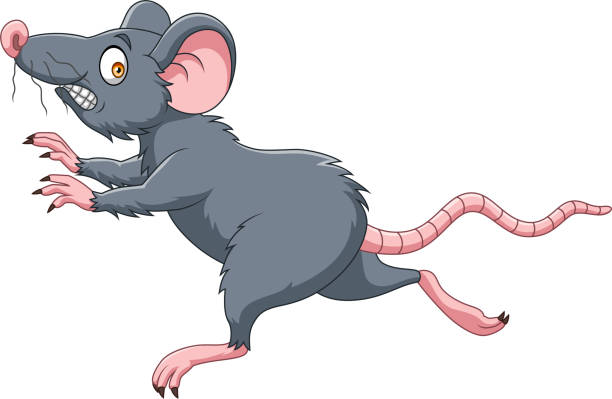Understanding Rodents in Arizona
Arizona is known for its diverse landscapes, ranging from arid deserts to majestic mountain ranges that showcase the incredible adaptability of nature. Because of its unique environment, Arizona is home to a rich and varied population of rodents. Rats, mice and gophers are the most common among these, each with its own unique characteristics and habits. Read on for some tips and insight regarding common rodents seen throughout Arizona.
The Diversity of Arizona’s Rodent Population
Rodents are often thought of as small, scurrying creatures with a penchant for mischief, however the rodent population in Arizona is surprisingly diverse, ranging from tiny, delicate mice to larger, more robust rats, as well as subterranean experts like gophers.
Rats
In Arizona, rats are a prevalent rodent species, with two common varieties being the roof rat and the Norway rat. Roof rats, also known as black rats, are known for their agility and climbing skills. These rodents often choose to create their nests in high places, such as trees and attics. Their acrobatic abilities make them well-suited to urban environments, where they can easily access elevated locations. On the other hand, Norway rats have different habits and preferences. They are burrowing rodents, favoring the creation of underground hideouts. These rats adapt well to a variety of environments, including urban areas and agricultural fields. Their subterranean lifestyle provides them with protection from predators and the elements. Understanding the distinctions between these two rat species is crucial for effective pest control, as it allows for tailored approaches to address infestations and minimize their impact on homes and businesses.
Mice
Arizona hosts a variety of mouse species, including the house mouse, deer mouse and white-footed mouse. These mice are prevalent in the state and have distinctive characteristics that set them apart from their larger counterparts, rats.
Mice are generally smaller than rats, making them less conspicuous in their movements. Their diminutive size allows them to navigate through tiny openings with remarkable ease, a trait that often leads them into homes, barns and other structures. This ability to squeeze through narrow gaps makes them adept at infiltrating buildings, where they seek shelter, warmth and sustenance.
The house mouse, deer mouse and white-footed mouse are well-suited to Arizona’s diverse environments, adapting to both urban and rural settings. Their presence can be subtle, and they may remain out of sight for extended periods, making them challenging to detect until their numbers grow significantly.
Understanding the behavior and habits of these mice species is essential for effective pest control measures. Identifying their entry points and taking proactive steps to seal off potential access areas can help prevent infestations. Additionally, recognizing the signs of a mouse presence, such as droppings and gnawed materials, allows homeowners and business owners to address issues promptly, minimizing damage and potential health risks associated with mice infestations.
Gophers
In Arizona’s vast deserts and arid landscapes, gophers find their ideal habitat, with the pocket gopher being a prominent species in these areas. These subterranean rodents have honed their skills as expert diggers, fashioning intricate tunnel systems beneath the earth’s surface. One of the telltale signs of their activity is the mounds of soil they push up to the ground while diligently tunneling.
Gophers are especially adapted to thrive in Arizona‘s challenging terrain. Their subterranean lifestyle not only provides them with protection from predators but also grants them access to moisture hidden deep within the earth. These resilient creatures have evolved to make the most of the arid conditions, allowing them to thrive where others might struggle.
Their tunneling behavior serves multiple purposes, including foraging for food and creating shelter. Gophers are also known for their voracious appetites, and their underground tunnels allow them to seek out roots, tubers and other plant materials that make up a significant part of their diet. This feeding behavior can have consequences for agriculture, as gophers can damage crops and disrupt landscapes.
The intricate tunnel systems they create also play a role in soil aeration and can even influence water infiltration patterns. While gophers are essential components of the ecosystem, their presence can sometimes lead to conflicts when they encroach upon human settlements or agricultural areas.
Recognizing the signs of gopher activity, such as the characteristic mounds of soil, is essential for property owners in Arizona. Understanding their behavior and ecological significance can help individuals coexist with these subterranean rodents while minimizing potential conflicts. When gopher populations become problematic, seeking professional assistance in managing their presence can be a prudent step to protect both property and the local environment.
Understanding the diversity of these rodent species is essential for effective pest control. Different species have different behaviors and preferences, which means that addressing an infestation may require a tailored approach.
Rodent Behavior Throughout the Year
Rodents are incredibly adaptable creatures, capable of surviving in various environments and climates. To understand why they become more problematic during the winter months, it’s crucial to examine their behavior throughout the year.
Spring
In Arizona, spring ushers in warmer temperatures and an abundance of food sources, creating ideal conditions for rodents to flourish. Among these rodents, rats and mice stand out as remarkably prolific breeders, with the potential to rapidly increase their numbers in a short span of time.
As temperatures rise and vegetation begins to thrive, rodents find themselves in an environment rich with resources. The increased availability of food, such as seeds, grains and plant materials, provides rodents with the sustenance needed to support a growing population.
Rats and mice are particularly skilled at taking advantage of these favorable conditions. A single pair of rats or mice can reproduce rapidly, with a gestation period as short as three weeks. Once born, their offspring are quick to mature, and the cycle repeats. This exponential rate of reproduction is a key factor in their ability to become a pervasive presence in their surroundings.
In the springtime, rodents are not only focused on breeding but also on securing shelter for their burgeoning families. This drive to establish nests and find safe hiding spots can bring them into closer proximity to human dwellings. As a result, homeowners and businesses may notice an increase in rodent activity during this season.
Understanding the seasonal patterns of rodent behavior allows property owners to be proactive in pest management. Taking steps to prevent rodent access to food sources and sealing off potential entry points can help mitigate infestations before they become overwhelming. Moreover, recognizing the signs of rodent presence, such as droppings or gnaw marks, enables early intervention, reducing the likelihood of a severe infestation.
Summer
Arizona’s scorching summers bring unique challenges for rodents, compelling them to seek respite from the relentless heat. As temperatures soar, rodents are driven to find cooler and shaded environments, often leading them into the interiors of homes and businesses.
The searing heat of an Arizona summer is not conducive to the comfort of rodents. With their sensitivity to extreme temperatures, these creatures instinctively seek refuge from the blistering sun. Seeking cooler and shaded areas becomes a priority for their survival. As a result, they are drawn to the inviting coolness of buildings and structures.
Rodents are also known for their adaptability, and during the summer months, they adjust their behavior to minimize exposure to the harsh daytime conditions. To avoid the sweltering heat, they may become more active during the evening and nighttime hours when temperatures are more tolerable. This nocturnal behavior allows them to forage for food and explore their surroundings while avoiding the sun.
Homeowners and business owners in Arizona should be particularly vigilant during the summer months, as this is when rodent activity indoors tends to peak. These unwelcome guests may find their way into buildings through gaps, cracks or open doors and windows, seeking both shelter and cooler temperatures.
Preventive measures, such as sealing off potential entry points and maintaining a clean environment that eliminates food sources, become crucial during the summer season. Recognizing the signs of rodent presence, such as droppings or chewed materials, is equally important for early intervention.
Fall
As the temperatures in Arizona begin to drop with the arrival of fall, rodents commence their search for warm and secure shelters to escape the impending cold. This transitional period marks a time when rodent infestations often reach their peak as these creatures increasingly seek refuge indoors.
Fall in Arizona brings a gradual but noticeable shift in weather. While the state’s winters are relatively mild compared to many other regions, the drop in temperatures can still be discomforting for rodents. As the days grow shorter and cooler, rodents become acutely aware of the changing environment. Their instincts drive them to find suitable shelters that offer protection from the cold, wind and potential precipitation.
This seasonal change prompts rodents to explore their surroundings more actively, seeking entry points into homes, businesses, and other structures. Gaps in foundations, cracks in walls, open vents and unsealed entryways become enticing invitations for these creatures to gain access to indoor environments.
Property owners often observe an uptick in rodent activity during the fall months as these animals become more brazen in their quest for warmth and shelter. Rodents can pose a multitude of problems when they infiltrate human living spaces, from contaminating food sources to damaging property and spreading diseases.
Recognizing the signs of a potential rodent infestation is crucial during the fall season. These signs may include the presence of droppings, chewed materials and the sounds of rodents scurrying within walls or ceilings. Early detection and swift action are vital to prevent infestations from becoming overwhelming.
To safeguard homes and businesses from fall rodent infestations, property owners can take proactive steps such as sealing off entry points, ensuring proper insulation, and maintaining a clean environment that reduces attractants. By understanding the behavioral patterns of rodents during the fall and taking preventive measures, individuals can better protect their properties from these seasonal invaders.
Winter
Despite Arizona’s reputation for milder winters in comparison to many other states, the chilly temperatures during this season prompt rodents to seek warmth and shelter. Consequently, the winter months frequently witness a notable increase in rodent activity within homes and businesses. Lower temperatures, particularly at night, can make outdoor environments less hospitable for rodents. As a result, these adaptable creatures turn their attention to the comfort and warmth provided by indoor spaces.
The winter season is a critical period for rodents to secure a cozy refuge, as it is a matter of survival for them. In their quest for shelter from the cold, rodents become more determined and enterprising in their attempts to gain access to homes, commercial establishments and other structures. This heightened activity can lead to an increased likelihood of infestations during the winter months.
Property owners often find themselves grappling with rodent-related challenges as these pests seek solace indoors. Rodents can create a range of problems, from contaminating food stores to causing structural damage and posing health risks to humans. Their propensity to chew through electrical wires also raises the potential for fire hazards.
To combat the influx of rodents during the winter, property owners should remain vigilant and implement effective pest control measures. This may include sealing off potential entry points, setting traps, and maintaining a clean environment that eliminates food sources. Recognizing the signs of rodent presence, such as droppings, gnaw marks or unusual sounds, is essential for early intervention.
Understanding these seasonal patterns allows homeowners and business owners to anticipate rodent behavior and take proactive measures to prevent infestations before they become a serious issue. A professional consultation with a pest control company can also be an easy way to stave off rodent activity.
Adapting to Arizona’s Unique Environment
Arizona’s distinctive environment plays a significant role in shaping the behavior of its rodent population. The state’s arid deserts, vast open spaces and diverse ecosystems provide a range of niches for rodents to inhabit.
Desert Adaptations
Rodents like gophers have evolved unique adaptations to thrive in Arizona’s desert landscapes. Their ability to tunnel underground not only provides protection from predators but also allows them to access moisture deep within the earth.
Urban Challenges
In urban areas, rodents face different challenges. They often seek out human structures for food and shelter, leading to conflicts with homeowners and business owners. Understanding these urban challenges is crucial for effective pest management in populated areas.
Agricultural Impact
Arizona’s agriculture industry also contends with rodent-related challenges. Rats and mice can damage crops, contaminating food supplies and causing economic losses.
Understanding the intricacies of Arizona’s rodent population, their behavior throughout the year and their adaptations to the unique environment empowers residents and business owners to protect their properties effectively. By appreciating the diversity of rodent species and their roles in the ecosystem, we can coexist with these creatures while minimizing the risks they pose to our well-being and surroundings.

Why choose us?
At 520 Termite & Pest Solutions, we have decades of experience servicing the pest control needs of Valley residential and commercial customers. As a family-owned company, we offer services without contracts, sign-up fees or long-term obligations because we are committed to providing exceptional, risk-free inspections and treatments.
Our expertly trained technicians receive ongoing training to ensure they stay up to date with the newest methods and technology, giving you the peace of mind that whenever you work with us you have access to the best and most advanced treatment options.
We service Tucson, Phoenix and many other parts of Southern Arizona, so if your property is experiencing issues with termites, rodents or other pests, don’t delay in seeking a solution. Contact us today for a free estimate!

